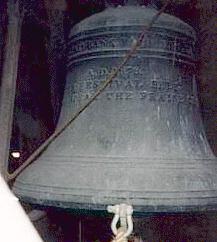![]() The History of Saint Mark's Bells
The History of Saint Mark's Bells
In the summer of 1876, four bells which were made by the historic firm of Mears and Stainbank at Whitechapel, England, were hung in a frame of English oak with all the fittings for change ringing. This is the same foundry which originally cast the Liberty Bell. To view some pictures of Saint Mark's bells, read the texts of the inscriptions and examine their weights, please look at this table .
The bells were test rung for the first time on Saturday June 24, 1876. A notice in the Philadelphia Evening Bulletin read:
During the past week four of a peal of eight bells have been placed in the tower of Saint Mark's Church. These bells have a very rich musical tone, and were cast by the old English firm of Mears and Stainbank...These bells will be first tested this afternoon at half past six o'clock, at which time the 'changes' will be rung according to the old style which has been preserved since the fifteenth century in the Church of England.
In 1876, the residential area surrounding Saint Mark's Church was a wealthy neighborhood. When Saint Mark's neighbors heard that the church was planning to install a ring of bells, they were upset. Before the bells were hung, a letter signed by twenty-five property owners was presented at a meeting of the vestry. Neighbors were mainly concerned about noise, though some felt the tower might fall if the bells were swung too much. On June 25, 1876, the bells were first rung for Sunday services. Persons wary before the installation were justifiably angered by the bells. The rector instructed the bell ringers to ring the bells for one half hour prior to each service. The earliest service was at seven o'clock A.M. Thus, many people were rudely awakened when the bells began tolling at half past six o'clock A.M. Letters and protests were made by residents surrounding the church, some of whom were parish members. The vestry paid no heed and insisted that Saint Mark's had the sole right to ring the bells as the church saw fit. In November, a petition with the signatures of forty-eight households was handed to Saint Mark's vestry requesting that the, "early, frequent, prolonged ringing be discontinued excepting a single service." Accompanying the petition was a letter signed by 14 physicians stating that the ringing was "prejudicial to the health of some and to the discomfort of many." The rector discontinued the ringing of the bells for the earliest service; however, ringing continued for the three other services at Saint Mark's each Sunday.
![]() The Bell Trial
The Bell Trial
On January 2, 1877, an injunction was filed with the Court of Common Pleas of the Commonwealth of Pennsylvania to restrain the ringing of Saint Mark's bells. During the next two months depositions were taken by numerous neighbors, clergymen, musicians, bell ringers, medical experts and people living near other churches with rings of bells. Lawyers for both sides made enraptured arguments.
On February 24, 1877 the court issued an injunction "restricting the defendants from ringing the bells of St. Mark's Church or otherwise use the same so as to cause nuisance or annoyance, by sound or noise, to the complainant, or any of them, within their respective houses." Further, the judgment called for the security of one thousand dollars to be paid to the city by the church to insure their good behavior. The next Sunday, a satirical poem appeared in the Philadelphia Sunday Dispatch.
The ruling was appealed by Saint Mark's Church. The Pennsylvania State Supreme Court relaxed the injunction in two separate rulings in 1877 and 1878 allowing Saint Mark's Church's bells to again sound on Locust Street.
In 1878 enough money had been raised for the purchase of four more bells to add to the original four. The church returned to the Whitechapel bell foundry in England to complete the peal. The new bells along with the older ones were re-hung in a new frame higher up in the steeple. The idea was to decrease the amount of the noise by increasing the distance of the bells from the street and from many upper story windows. Unfortunately the new frame did not allow the bells to swing adequately for change ringing. Soon the bells were neglected and rarely rung.
 |
|
The historical information contained in this page is a summary of the article "Bells on Trial" by A. Thomas Miller, which was first published in The Clapper, publication of the North American Guild of Change Ringers Vol. 15 No. 3, Summer, 1988. To read the entire article, please click on the hypertext in the previous sentence.